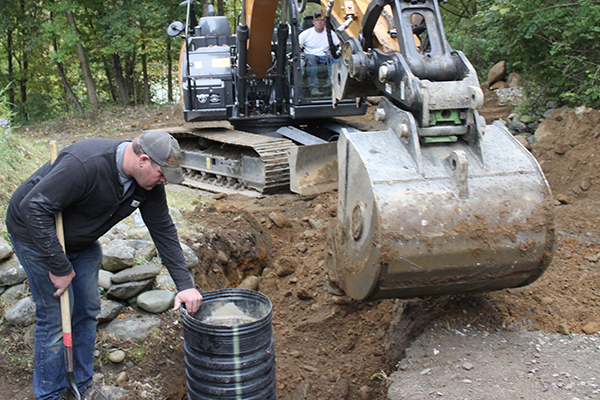I own and operate an excavation company in northern Vermont. In addition to our site work projects, we provide snow plowing and removal services to local residences. Last summer, one of our plowing customers approached us about fixing his 400-foot-long driveway (this was great news because the gravel road was steep, pretty gnarly with ruts, and tough on our plows).
We replaced several rusted-out galvanized culverts with new corrugated HDPE ones and regraded the driveway and parking areas. Included in the scope of work was managing stormwater runoff from the sloping backyard and the roof, which would occasionally flood the existing basement via a walkout basement door that was cut in years after the foundation was poured in the 1980s. The homeowner mentioned that the flooding seemed to occur with greater frequency lately, mainly after deluges from intense summer thunderstorms.
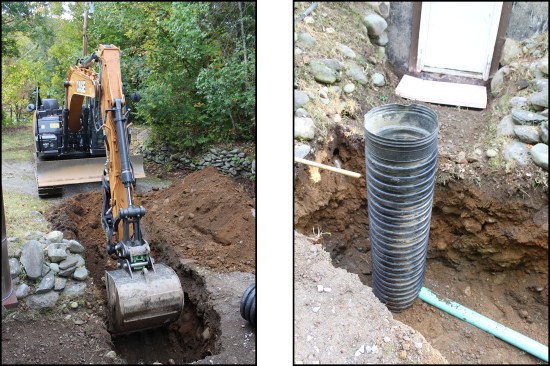
Excavation begins at the basement walkout (left). A length of 15-inch-diameter HDPE culvert installed vertically acts as a catch basin; 4-inch SDR-35 pipe inserted into the culvert’s base serves as an outlet (right).
Rather than redirecting the stormwater away from the walkout area and contributing more runoff toward the steep driveway, we suggested installing a catch basin in front of the basement door and running the stormwater to daylight.
Catch basins. We install catch basins for stormwater management fairly often on residential projects. Depending on the location, we install either concrete catch basins (for high-traffic areas, such as the middle of a driveway) or catch basins made with corrugated HDPE plastic culverts installed vertically (for low-traffic areas, such as the basement walkout on this project). A plastic catch basin offers a more economical drainage solution than a concrete one with a heavy cast-iron grate, which can run $1,000 or more.
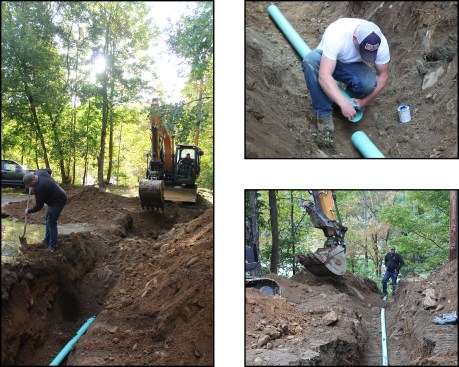
The 75-foot run to daylight is excavated in two sections: first the walkout end, then the daylight end (left). A crew member joins lengths of SDR-35 with PVC cement (top right). The daylight-side piping is complete and ready for backfilling (bottom right).
For this application, where the catch basin will serve as interior flood protection against occasional high-volume rain events, we installed a 15-inch-diameter pipe. In wetter low-traffic areas, we typically install wider diameter HDPE pipes.
Installation. We began excavation at the basement walkout with our 15-ton excavator, digging a trench below the frostline in the site’s bony gravel soil. Prior to installing the culvert, we bored a 4-inch-diameter hole at the bottom of it, using a cordless drill fitted with a coring bit, to receive the outlet pipe. We rolled the length of corrugated pipe into the trench, then inserted the 4-inch SDR-35 outlet pipe into the vertically installed culvert’s base.
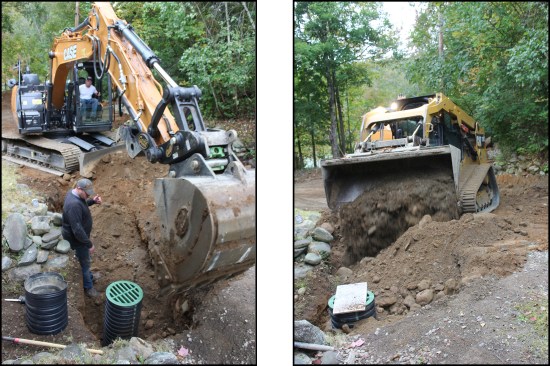
After the HDPE pipe is trimmed closer to grade, the basin’s heavy-duty HDPE grate is dryfit to prevent dirt and stone from entering the basin (left) during backfilling (right).
With the basement-walkout end plumbed, we began excavating the daylight end, some 75 feet away. The daylight side dropped off precipitously, some 60 feet down, so we were mindful about digging at that end of the trench. (An upside to excavating in northern Vermont’s hilly topography is it’s usually easy to drain to daylight, as opposed to flatter terrain where the only option is to pump water back to the surface.)
We dug as far as we could from the ends, then moved the excavator to the side to dig the middle of the trench.
We joined the lengths of SDR-35 outlet pipe with Hercules PVC cement, which we get from Northeast supplier E.J. Prescott. Hercules cement is a one-step, rain-or-shine cement that we’ve had good luck with over the years. With the daylight-end piping complete, we began backfilling the trench.
Back at the walkout side, we cut the length of vertical pipe closer to grade, then inserted our heavy-duty HDPE plastic grate and placed a scrap piece of plywood over the grate to prevent dirt and stone from entering the catch basin as we backfilled around it.
Finishing up. We cut the catch basin to its desired height, several inches below the existing basement’s slab elevation, then installed clay soils over 4 inches of XPS insulation placed over the exposed existing footing (a result of the basement walkout cut in after initial construction). We sloped the clay away from the house toward the basin, and then put in some large ditch stone around the finished grate.
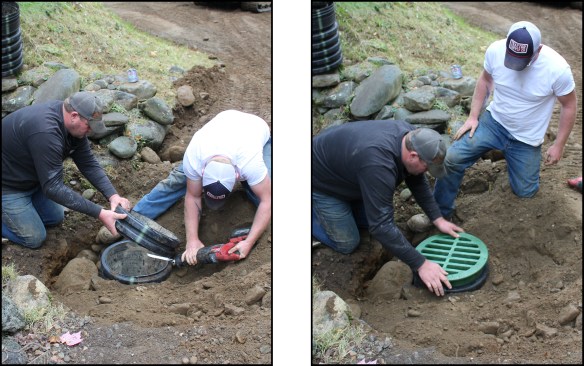
The pipe is cut to its finished height, a few inches below slab height (left), then the heavy-duty HDPE plastic grate is set (right).
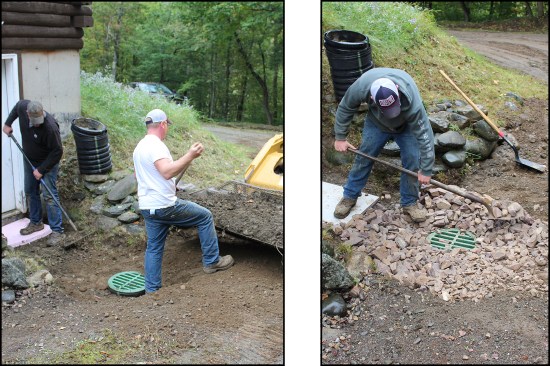
Clay soils are used to create a slope away from the house toward the basin (left). Ditch stone is applied around the finished basin (right).
For about $500 in materials and a day’s labor, we provided a stormwater runoff solution for the homeowner’s flood-prone basement walkout.
Photos by Tim Healey.
